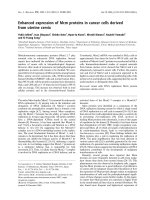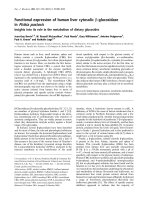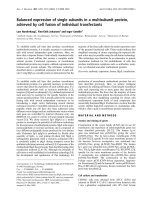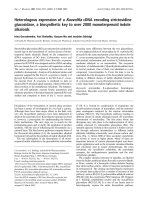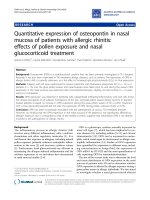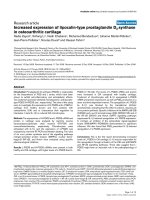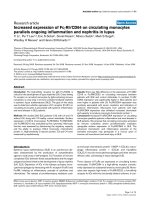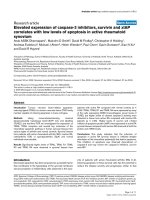Báo cáo y học: "Enhanced expression of mRNA for nuclear factor κB1 (p50) in CD34+ cells of the bone marrow in rheumatoid arthritis" potx
Bạn đang xem bản rút gọn của tài liệu. Xem và tải ngay bản đầy đủ của tài liệu tại đây (1.13 MB, 10 trang )
Open Access
Available online />Page 1 of 10
(page number not for citation purposes)
Vol 8 No 2
Research article
Enhanced expression of mRNA for nuclear factor κB1 (p50) in
CD34+ cells of the bone marrow in rheumatoid arthritis
Shunsei Hirohata
1
, Yasushi Miura
2
, Tetsuya Tomita
3
, Hideki Yoshikawa
3
, Takahiro Ochi
4
and
Nicholas Chiorazzi
5
1
Department of Internal Medicine, Teikyo University School of Medicine, Tokyo 173-8605, Japan
2
Department of Rheumatology, Kobe University FHS School of Medicine, Kobe 654-0142, Japan
3
Department of Orthopedic Surgery, Osaka University Medical School, Osaka 565-0871, Japan
4
Sagamihara National Hospital, Kanagawa 228-8522, Japan
5
Experimental Immunology and Rheumatology, North Shore-LIJ Research Institute, Manhasset, NY 11030, USA
Corresponding author: Shunsei Hirohata,
Received: 1 Oct 2005 Revisions requested: 8 Nov 2005 Revisions received: 27 Jan 200
6 Accepted: 9 Feb 2006 Published: 6 Mar 2006
Arth
ritis Research & Therapy 2006, 8:R54 (doi:10.1186/ar1915)
This article is online at: />© 2006 Hirohata et al.; licensee BioMed Central Ltd.
This is an open access article distributed under the terms of the Creative Commons Attribution License ( />),
which permits unrestricted use, distribution, and reproduction in any medium, provided the original work is properly cited.
Abstract
Bone marrow CD34+ cells from rheumatoid arthritis (RA)
patients have abnormal capacities to respond to tumor necrosis
factor (TNF)-α and to differentiate into fibroblast-like cells
producing matrix metalloproteinase (MMP)-1. We explored the
expression of mRNA for nuclear factor (NF)κB in RA bone
marrow CD34+ cells to delineate the mechanism for their
abnormal responses to TNF-α. CD34+ cells were purified from
bone marrow samples obtained from 49 RA patients and 31
osteoarthritis (OA) patients during joint operations via aspiration
from the iliac crest. The mRNAs for NFκB1 (p50), NFκB2 (p52)
and RelA (p65) were examined by quantitative RT-PCR. The
expression of NFκB1 mRNA in bone marrow CD34+ cells was
significantly higher in RA than in OA, whereas there was no
significant difference in the expression of mRNA for NFκB2 and
RelA. The expression of NFκB1 mRNA was not correlated with
serum C-reactive protein or with the treatment with methotrexate
or oral steroid. Silencing of NFκB1 by small interfering RNA
abrogated the capacity of RA bone marrow CD34+ cells to
differentiate into fibroblast-like cells and to produce MMP-1 and
vascular endothelial growth factor upon stimulation with stem
cell factor, granulocyte-macrophage colony stimulating factor
and TNF-α without influencing their viability and capacity to
produce β2-microglobulin. These results indicate that the
enhanced expression of NFκB1 mRNA in bone marrow CD34+
cells plays a pivotal role in their abnormal responses to TNF-α
and, thus, in the pathogenesis of RA.
Introduction
Rheumatoid arthritis (RA) is a chronic inflammatory disease
characterized by hyperplasia of synovial lining cells, consisting
of macrophage-like type A synoviocytes and fibroblast-like
type B synoviocytes [1]. It has been appreciated that type A
synoviocytes, which are also called intimal macrophages, are
derived from monocyte precursors in the bone marrow [1]. On
the other hand, type B synoviocytes, which are also called
fibroblast-like synoviocytes, have the morphological appear-
ance of fibroblasts as well as the capacity to produce and
secrete a variety of factors, including proteoglycans,
cytokines, arachidonic acid metabolites, and matrix metallo-
proteinases (MMPs), that lead to the destruction of joints [1].
Apart from type A synoviocytes, the origin of type B synovio-
cytes has been unclear [1]. Of note, we have recently demon-
strated that bone marrow CD34+ cells from RA patients have
abnormal capacities to respond to tumor necrosis factor
(TNF)-α and to differentiate into fibroblast-like cells producing
MMP-1, suggesting that bone marrow CD34+ progenitor
cells might generate type B synoviocytes and thus could play
an important role in the pathogenesis of RA [2].
TNF-α is one of the first triggers to be found effective for the
activation of nuclear factor (NF)κB in RA synovium [3]. This
β
2
MG = β
2
-microglobulin; ELISA = enzyme-kinked immunosorbent assay; GM-CSF = granulocyte-macrophage colony stimulating factor; HSCT =
hematopoietic stem cell transplantation; MFI = mean fluorescence intensity; MMP = matrix metalloproteinase; MTX = methotrexate; NFκB = nuclear
factor kappa B; OA = osteoarthritis; PCR = polymerase chain reaction; PE = phychoerythrin; RA = rheumatoid arthritis; SCF = stem cell factor; siRNA
= small interfering RNA; TNF-α = tumor necrosis factor-alpha; VEGF = vascular endothelial growth factor.
Arthritis Research & Therapy Vol 8 No 2 Hirohata et al.
Page 2 of 10
(page number not for citation purposes)
mechanism of activation was followed by up-regulation of sev-
eral inflammatory genes usually found in active RA. Accord-
ingly, a number of studies have shown that TNF-α blockade
has beneficial effects in the treatment of RA [4]. Moreover,
inhibition of NFκB by the antioxidant N-acetylcysteine signifi-
cantly reduced TNF-α- and NFκB-dependent gene expression
and synovial proliferation [3]. We thus hypothesized that
abnormal responses of RA bone marrow CD34+ cells to TNF-
α might result from abnormal expression of NFκB genes. The
current studies were undertaken, therefore, to explore the
expression of mRNA for various components of NFκB in bone
marrow CD34+ cells in RA.
Materials and methods
Patients and samples
Bone marrow samples were obtained from 49 patients with
RA (8 males and 41 females: mean age, 58.6 years; age
range, 35 to 78 years) who satisfied the American College of
Rheumatology 1987 revised criteria for RA [5] and gave
informed consent in accordance with the World Medical Asso-
ciation Declaration of Helsinki Ethical Principles for Medical
Research Involving Human Subjects. The samples were taken
during joint operations via aspiration from the iliac crest under
anesthesia. As a control, bone marrow samples were similarly
obtained from 31 patients with osteoarthritis (OA; 3 males and
28 females; mean age, 71.2 years; age range, 49 to 81 years)
who gave informed consent. Most patients with RA and OA
were taking non-steroidal anti-inflammatory drugs. Of the 45
patients with RA, 23 were treated with low dose methotrexate
(MTX) and 33 were taking oral steroids when bone marrow
samples were obtained. No OA patients were taking MTX or
oral steroid.
Preparation of bone marrow CD34+ cells
Mononuclear cells were isolated by centrifugation of
heparinized bone marrow aspirates over sodium diatrizoate-
Ficoll gradients. CD34+ cells were purified from the mononu-
clear cells by positive selection with magnetic beads (CD34
progenitor cell selection system; Dynal, Oslo, Norway). The
cells thus prepared were >95% CD34+ cells and <0.5%
CD19+ B cells, as previously described [2]. In addition,
CD34+ cells derived from bone marrow aspirates from the
iliac crests of healthy individuals (purity >95%) were pur-
chased from BioWhittaker (Walkersville, MD, USA).
RNA isolation and real-time quantitative PCR
Total RNA was isolated from purified bone marrow CD34+
cells using the Trizol reagent (Life Technologies, Grand Island,
NY, USA) according to the manufacturer's instructions. cDNA
samples were prepared from 1 µg of total RNA using the
SuperScript reverse transcriptase preamplification system
(Life Technologies) with oligo (dT) primer and subjected to
PCR. Real-time quantitative PCR was performed using the
LightCycler rapid thermal cycler system (Roche Diagnostics,
Lewes, UK) with primer sets for NFκB1, NFκB2, RelA or β-
actin and Light Cycler-Fast Start DNA master SYBR Green I
(Roche Diagnostics). The primers were designed using Oligo
Primer Analysis Software version 5.0 (Takara Bio Inc., Ohtsu,
Japan). The detail of primer sequences is shown in Table 1.
Quantitative analysis was performed using LightCycler Soft-
ware v.3.5. PCR reaction conditions composed of denaturing
at 95°C for 10 minutes for 1 cycle, followed by 40 cycles of
denaturing (10 seconds at 95°C), annealing (10 seconds at
60°C (NFκB2, RelA) or 62°C (NFκB1, β-actin)), and extension
(5 seconds (NFκB1), 6 seconds (NFκB2, RelA), or 10 sec-
onds (β-actin) at 72°C).
Table 1
Primer sequences used in real-time quantitative PCR for analysis of mRNA for various nuclear factor κB components
Gene product (GenBank accession no.) Primer sequences Nucleotides
NFκB1 [M58603] Forward: 5'-TCC ACA AGG CAG CAA ATA GA-3' 3,125–3,144
Reverse: 5'-GGG GCA TTT TGT TGA GAG TT-3' 3,244–3,263
NFκB2 [NM_002502
] Forward: 5'-TTC TGA AGG CTG GTG CTG AC-3' 2,220–2,239
Reverse: 5'-AGT GAG GTC AAG AGG CGT GT-3' 2,352–2,371
RelA [NM_021925
] Forward: 5'-GAA GAA GAG TCC TTT CAG CG-3' 1,011–1,030
Reverse: 5'-GGG AGG ACG TAA AGG GAT AG-3' 1,116–1,135
β-actin [X00351
] Forward: 5'-GCA AAG ACC TGT ACG CCA AC-3' 910–929
Reverse: 5'-CTA GAA GCA TTT GCG GTG GA-3' 1,150–1,169
Available online />Page 3 of 10
(page number not for citation purposes)
Immunofluorescence staining and analysis
Purified bone marrow CD34+ cells (obtained from three RA
patients and three OA patients) were treated with IntraPrep™
Permeabilization Reagent (Immunotech, Marseille, France),
followed by staining with phycoerythrin (PE)-conjugated anti-
NFκB p50 (E-10; a mouse IgG1 monoclonal antibody against
amino acids 120 to 239 mapping at the amino terminus of
human NFκB p50; Santa Cruz Biotech, Santa Cruz, CA, USA)
or PE-conjugated normal mouse IgG1 (Santa Cruz). The cells
were analyzed using an EPICS XL flow cytometer (Coulter,
Hialeah, FL, USA) equipped with an argon-ion laser at 488 nm.
A combination of low-angle and 90° light scatter measure-
ments (forward scatter versus side scatter) was used to gen-
erate a bit map gating to identify bone marrow cells using
Cyto-Trol™ Control Cells (Coulter) and Immuno-Trol™ Cells
(Coulter) as standards. Specific mean fluorescence intensity
(MFI) for NFκB1 (p50) was calculated by subtracting the non-
specific MFI of staining with the isotype-matched control
mouse IgG1.
Culture medium and cytokines
RPMI 1640 medium (Life Technologies) supplemented with L-
glutamine (0.3 mg/ml) and 10% fetal bovine serum (Life Tech-
nologies) was used for all cultures. Recombinant human stem
cell factor (SCF), granulocyte-macrophage colony stimulating
factor (GM-CSF), and TNF-α were purchased from Pepro
Tech EC (London, UK).
Silencing of NFκB1 in bone marrow CD34+ cells by small
interfering RNA
SMARTpool
®
small interfering RNA (siRNA) for NFκB1 (p50)
gene and nonsense scrambled control siRNA were purchased
from Dharmacon (Lafayette, CO, USA). Chemical transfection
of siRNAs into bone marrow CD34+ cells was performed
using siPORT™ Amine Transfection Agent (Ambion, Austin,
TX, USA) according to the manufacturer's directions. Briefly,
purified bone marrow CD34+ cells were cultured in a 24-well
microtiter plate (N0. 3524; Costar, Cambridge, MA, USA) at 2
× 10
5
cells per well in 0.2 ml culture medium in the presence
of SCF (10 ng/ml) and GM-CSF (1 ng/ml). After 24 hours of
incubation, chemical transfection of siRNAs was performed,
and incubated for 4 hours.
Cell cultures and measurement of MMP-1 and vascular
endothelial growth factor
After transfection of siRNAs, the cells were cultured with SCF
(10 ng/ml) and GM-CSF (1 ng/ml) in 1.0 ml culture medium for
Figure 2
Expression of nuclear factor (NF)κB1 (p50) protein in bone marrow CD34+ cellsExpression of nuclear factor (NF)κB1 (p50) protein in bone marrow
CD34+ cells. Purified bone marrow CD34+ cells from a rheumatoid
arthritis patient were permeabilized and then stained with phychoeryth-
rin-conjugated anti-NFκB p50 monoclonal antibody or phychoerythrin-
conjugated normal mouse IgG1, followed by analysis with flow cytome-
try. The level of NFκB1 protein was expressed by mean fluorescence
intensity as described in Materials and methods.
Figure 1
The expression of mRNAs for nuclear factor (NF)κB1 (p50), NFκB2 (p52) and RelA (p65) in bone marrow CD34+ cellsThe expression of mRNAs for nuclear factor (NF)κB1 (p50), NFκB2 (p52) and RelA (p65) in bone marrow CD34+ cells. Total RNA was isolated
from purified bone marrow CD34+ cells. The expression of mRNAs for NFκB1, NFκB2, RelA and β-actin was evaluated by real-time quantitative
PCR. The data are expressed as the ratio of the mRNA copy numbers to those of β-actin. Horizontal lines indicate the mean values. Statistical signif-
icance was evaluated by Welch's t test. OA, osteoarthritis; RA, rheumatoid arthritis.
Arthritis Research & Therapy Vol 8 No 2 Hirohata et al.
Page 4 of 10
(page number not for citation purposes)
48 hours and then harvested for RNA extraction. Alternatively,
the cells were cultured in a 24-well microtiter plate at 2 × 10
5
cells per well in 1.0 ml culture medium for 4 weeks in the pres-
ence of SCF (10 ng/ml), GM-CSF (1 ng/ml) and TNF-α (10
ng/ml) without medium change, as previously described [2].
The differentiation of fibroblast-like cells was observed under
the phase-contrast light microscopy. The concentrations of
MMP-1 and vascular endothelial growth factor (VEGF) in the
culture supernatants were measured using the Biotrak human
MMP-1 ELISA system (Amarsham Pharmacia Biotech, Buck-
inghamshire, UK) and human VEGF immunoassay kit (Bio-
Source International, Camarillo, CA, USA), respectively. The
concentrations of β
2
-microglobulin (β
2
MG) were determined
by an ELISA as previously described [6].
Statistics
Comparison between RA and OA patients and between RA
patients with MTX or steroid and those without MTX or steroid
was carried out using Welch's t test. Significance of the
effects of siRNA transfection on the generation of fibroblast-
like cells and on the production of MMP-1 and VEGF was eval-
uated by Wilcoxon's signed rank test. Correlation between
serum C-reactive protein and NFκB1 mRNA in bone marrow
CD34+ cells and that between NFκB1 mRNA and protein
were evaluated using a liner regression test. Correlation
between NFκB1 mRNA in bone marrow CD34+ cells and the
generation of fibroblast-like cells was analyzed using a Spear-
man's rank correlation test.
Results
Expression of mRNAs for various components of NFκB in
bone narrow CD34+ cells
The expression of mRNA for NFκB1 (p50), NFκB2 (p52), and
RelA (p65) in bone marrow CD34+ cells is shown as the ratio
of the copy numbers to those of β-actin mRNA in Figure 1. The
expression of NFκB1 mRNA was significantly higher in RA
bone marrow CD34+ cells than in OA bone marrow CD34+
cells (p = 0.005351), whereas there were no significant differ-
ences in the expression of NFκB2 mRNA (p = 0.130116).
Although the expression of RelA mRNA appeared to be lower
in RA bone marrow CD34+ cells than in OA bone marrow
CD34+ cells, it did not reach statistical significance (p =
0.192150). These results indicate that the expression of
mRNA for components of NFκB1 is exclusively enhanced in
bone marrow CD34+ cells from patients with RA.
Next, experiments were carried out to examine whether the
elevation of NFκB1 mRNA expression parallels the elevation of
NFκB1 protein expression in bone marrow CD34+ cells. The
protein expression of NFκB1 was evaluated by staining of per-
meabilized bone marrow CD34+ cells from three RA patients
and three OA patients with anti-NFκB p50 monoclonal anti-
body, followed by analysis with flow cytometry. As can be seen
Figure 4
The relevance of treatment with the expression of mRNAs for nuclear factor (NF)κB1 mRNA in bone marrow CD34+ cellsThe relevance of treatment with the expression of mRNAs for nuclear
factor (NF)κB1 mRNA in bone marrow CD34+ cells. Total RNA was
isolated from purified bone marrow CD34+ cells from 45 rheumatoid
arthritis patients. The expression of mRNAs for NFκB1 and β-actin was
evaluated by real-time quantitative PCR. The data are expressed as the
ratio of the mRNA copy numbers to those of β-actin. Effect of treatment
with methotrexate (MTX) or oral steroids (Steroid) was evaluated by
Welch's t test. Horizontal lines indicate the mean values.
Figure 3
Comparison of the expression of nuclear factor (NF)κB1 (p50) protein with that of NFκB1 mRNA in bone marrow CD34+ cellsComparison of the expression of nuclear factor (NF)κB1 (p50) protein
with that of NFκB1 mRNA in bone marrow CD34+ cells. Purified bone
marrow CD34+ cells were permeabilized and then stained with phych-
oerythrin-conjugated anti-NFκB p50 monoclonal antibody or phycho-
erythrin-conjugated normal mouse IgG1, followed by analysis with flow
cytometry. The NFκB1 protein levels as expressed by mean fluores-
cence intensity were compared with NFκB1 mRNA levels (expressed
as the ratio of the mRNA copy numbers to those of β-actin) in bone
marrow CD34+ cells from six patients (three rheumatoid arthritis
patients and three osteoarthritis patients). Statistical significance was
evaluated by linear regression test.
Available online />Page 5 of 10
(page number not for citation purposes)
in Figure 2, bone marrow CD34+ cells express NFκB1 (p50)
protein, the quantity of which can be expressed as MFI. More-
over, there is significant correlation between MFI for NFκB1
and NFκB1 mRNA in the six bone marrow CD34+ cells (Fig-
ure 3). The results indicate that the elevation of NFκB1 mRNA
leads to the increase in NFκB1 protein expression.
Relevance of expression of NFκB1 mRNA in bone
marrow CD34+ cells from RA patients to treatment and
clinical parameters
Of note, 22 and 33 of the 45 RA patients were treated with
MTX and oral steroids, respectively, whereas no OA patients
were taking either MTX or oral steroids. It is therefore possible
that MTX and oral steroids might have affected the expression
of NFκB1 mRNA in bone marrow CD34+ cells. As shown in
Figure 4, however, there were no significant differences in the
expression of NFκB1 mRNA in bone marrow CD34+ cells
between RA patients taking MTX or oral steroids and those
who were not, although the expression of NFκB1 mRNA
appeared to be lower in RA patients taking MTX or oral ster-
oids. It is unlikely, therefore, that the medication the RA
patients were taking would have resulted in the upregulation of
NFκB1 mRNA expression in bone marrow CD34+ cells. It
should be also noted that the expression of NFκB1 mRNA in
bone marrow CD34+ cells was not significantly correlated
with serum C-reactive protein (CRP) levels in RA patients (Fig-
ure 5). The data thus indicate that the upregulation of NFκB1
mRNA in bone marrow CD34+ cells is independent of the
activity of the systemic inflammation, as reflected by serum
CRP.
Relevance of the expression of NFκB1 mRNA to the
generation of fibroblast-like cells
There was a variation in the expression of NFκB1 mRNA
among the RA patients. We next examined the relationship of
the initial levels of NFκB1 mRNA in RA bone marrow CD34+
cells with their capacity to differentiate into fibroblast-like cells.
As shown in Figure 6, there was a significant correlation
between the NFκB1 mRNA expression and the generation of
fibroblast-like cells from bone marrow CD34+ cells upon stim-
ulation with SCF, GM-CSF and TNF-α for 4 weeks in 12 RA
patients. The data indicate that the enhanced expression of
NFκB1 mRNA is important for the enhanced generation of
fibroblast-like cells.
Effect of TNF-α on the expression of mRNAs for various
components of NFκB in bone marrow CD34+ cells
Previous studies have demonstrated that TNF-α plays a critical
role in the pathogenesis of RA [4]. It is possible, therefore, that
the up-regulation of NFκB1 mRNA in bone marrow CD34+
cells might be secondary to the increased levels of TNF-α in
the born marrow; experiments were carried out to test this
possibility. Highly purified bone marrow CD34+ cells from
healthy individuals were cultured in the presence of TNF-α (10
ng/ml) for 24 hours, after which the expression of mRNA for
various components of NFκB was examined. As shown in Fig-
Figure 6
Comparison of the expression of nuclear factor (NF)κB1 (p50) mRNA in bone marrow CD34+ cells with their capacity to differentiate into fibroblast-like cellsComparison of the expression of nuclear factor (NF)κB1 (p50) mRNA
in bone marrow CD34+ cells with their capacity to differentiate into
fibroblast-like cells. The expression of NFκB1 mRNA in bone marrow
CD34+ cells from 12 rheumatoid arthritis patients was evaluated by
real-time quantitative PCR prior to the culture. The bone marrow
CD34+ cells were incubated in culture medium with stem cell factor
(10 ng/ml), granulocyte-macrophage colony stimulating factor (1 ng/ml)
and tumor necrosis factor-α (10 ng/ml) for 4 weeks with no medium
changes. Morphological changes were evaluated under light micros-
copy. The percentages of fibroblast-like cells were calculated from two
view fields at ×20 magnifications. The degree of the generation of
fibroblast-like cells were scored as follows: 0, fibroblast-like cells <5%;
1, fibroblast-like cells 5% to 25%; 2, fibroblast-like cells 25% to 50%;
3, fibroblast-like cells >50%; 4, formation of a pile or a cluster in at
least one view field. Statistical significance was evaluated by Spear-
man's rank correlation test.
Figure 5
The correlation of the expression of mRNAs for nuclear factor (NF)κB1 mRNA in bone marrow CD34+ cells with serum C-reactive protein (CRP)The correlation of the expression of mRNAs for nuclear factor (NF)κB1
mRNA in bone marrow CD34+ cells with serum C-reactive protein
(CRP). Total RNA was isolated from purified bone marrow CD34+ cells
from 45 rheumatoid arthritis patients. The expression of mRNAs for
NFκB1 and β-actin was evaluated by real-time quantitative PCR. The
data are expressed as the ratio of the mRNA copy numbers to those of
β-actin. Statistical significance was evaluated by linear regression test.
Arthritis Research & Therapy Vol 8 No 2 Hirohata et al.
Page 6 of 10
(page number not for citation purposes)
ure 7, treatment of bone marrow CD34+ cells with TNF-α
upregulated not only the expression of NFκB1 (p50) mRNA,
but that of NFκB2 (p52) mRNA and RelA (p65) mRNA. Since
only the expression of NFκB1 mRNA, but not that of NFκB2
mRNA and RelA mRNA, was significantly upregulated in RA
bone marrow CD34+ cells, the increased expression of
NFκB1 mRNA in RA bone marrow CD34+ cells might not be
accounted for simply by the increased levels of TNF-α in the
bone marrow.
Effect of silencing mRNA for NFκB1 on differentiation of
RA bone marrow CD34+ cells into fibroblast-like cells
upon stimulation with SCF, GM-SCF and TNF-α
We next examined whether silencing of NFκB1 (p50) mRNA
in RA bone marrow CD34+ cells might correct their abnormal
responses to TNF-α. As shown in Figure 8, treatment of bone
marrow CD34+ cells with siRNA for NFκB1 reduced the
expression of NFκB1 mRNA by approximately 80%. More
importantly, reduction of NFκB1 mRNA markedly suppressed
the generation of fibroblast-like cells from RA bone marrow
CD34+ cells upon stimulation with SCF, GM-CSF and TNF-α
(Figures 9 and 10). Accordingly, silencing of NFκB1 by siRNA
Figure 9
Inhibition of the generation of fibroblast-like cells by silencing nuclear factor (NF)κB1 mRNA in bone marrow CD34+ cells from patients with rheumatoid arthritisInhibition of the generation of fibroblast-like cells by silencing nuclear
factor (NF)κB1 mRNA in bone marrow CD34+ cells from patients with
rheumatoid arthritis. Purified bone marrow CD34+ cells were trans-
fected with small interfering RNA (siRNA) for NFκB1 or a scrambled
sequence control, after which the cells were incubated in culture
medium with stem cell factor (10 ng/ml), granulocyte-macrophage col-
ony stimulating factor (1 ng/ml) and tumor necrosis factor-α (10 ng/ml)
for 4 weeks with no medium changes. Morphological changes were
observed under light microscopy (original magnification, ×20; inset,
×50 magnification). The data are representative of 12 different experi-
ments.
Figure 7
Effect of tumor necrosis factor (TNF)-α on the expression of mRNAs for nuclear factor (NF)κB1 (p50), NFκB2 (p52) and RelA (p65) in bone marrow CD34+ cellsEffect of tumor necrosis factor (TNF)-α on the expression of mRNAs for nuclear factor (NF)κB1 (p50), NFκB2 (p52) and RelA (p65) in bone marrow
CD34+ cells. Bone marrow CD34+ cells from healthy individuals were incubated in culture medium with or without TNF-α (10 ng/ml) for 24 hours.
After the incubation, total RNA was isolated for evaluation of the expression of mRNAs for NFκB1, NFκB2, RelA and β-actin by real-time quantitative
PCR. The data are expressed as the ratio of the mRNA copy numbers to those of β-actin. The data are representative of two different experiments.
Figure 8
Silencing of nuclear factor (NF)κB1 mRNA in bone marrow CD34+ cells by small interfering RNA (siRNA) for NFκB1Silencing of nuclear factor (NF)κB1 mRNA in bone marrow CD34+
cells by small interfering RNA (siRNA) for NFκB1. Purified bone mar-
row CD34+ cells were transfected with siRNA for NFκB1 or a scram-
bled sequence control siRNA after a 24 hours incubation in culture
medium with stem cell factor (10 ng/ml) and granulocyte-macrophage
colony stimulating factor (1 ng/ml). After the transfection, the cells were
further incubated for 48 hours in culture medium with stem cell factor
and granulocyte-macrophage colony stimulating factor, and total RNA
was isolated for evaluation of the expression of NFκB1 mRNA and β-
actin mRNA by real-time quantitative PCR. The data are expressed as
the ratio of the mRNA copy numbers to those of β-actin.
Available online />Page 7 of 10
(page number not for citation purposes)
significantly decreased the levels of MMP-1 and VEGF in cul-
ture supernatants of RA bone marrow CD34+ cells (Figure
11). Since bone marrow CD34+ cells proliferate in response
to SCF, GM-CSF and TNF-α, it was possible that differences
in MMP-1 and VEGF might be a result of alteration in cell pro-
liferation by NFκB1 siRNA. Previous studies disclosed that
β
2
MG is produced by a number of cell types, including lym-
phocytes, myeloid cells, and tumor cells [7-9]. The production
of β
2
MG generally correlates with cell proliferation [6-9]. In
fact, the levels of β
2
MG in the culture supernatants paralleled
the viable cell counts of bone marrow CD34+ cells stimulated
with SCF, GM-CSF and TNF-α. Of note, silencing of NFκB1
also significantly decreased the ratios of MMP-1 and VEGF to
β
2
MG (MMP-1/β
2
MG and VEGF/β
2
MG) in culture superna-
tants of RA bone marrow CD34+ cells (Figure 12). Consist-
ently, whereas siRNA for NFκB1 inhibited the differentiation of
RA bone marrow CD34+ cells stimulated with SCF, GM-CSF
and TNF-α into fibroblast-like cells (Figure 13), it significantly
influenced neither the viable cell numbers nor the levels of
β
2
MG in the culture supernatants (Figure 14). These results
confirm that the enhanced expression of NFκB1 mRNA in RA
bone marrow CD34+ cells led to their abnormal capacity to
differentiate into fibroblast-like cells producing MMP-1 upon
stimulation with SCF, GM-CSF and TNF-α without affecting
cell viability or proliferation. The data suggest, therefore, that
the enhanced expression of NFκB1 mRNA in bone marrow
hematopoietic stem cells might play a pivotal role in the patho-
genesis of RA.
Discussion
The importance of TNF-α in the pathogenesis of RA has been
well appreciated. Thus, anti-TNF-α antibodies and soluble
TNF receptors have been demonstrated to have beneficial
effects in the treatment of RA [4]. On the other hand, increas-
ing attention has been paid to the role of bone marrow abnor-
malities in the pathogenesis of RA. In this regard, we
demonstrated that RA bone marrow CD34+ cells have abnor-
mal capacities to respond to TNF-α and to differentiate into
fibroblast-like cells producing MMP-1 [2]. It should be noted
that NFκB plays an important role in signal transduction and
expression of a variety of genes, including MMP-1, under the
influence of TNF-α [3]. The results in the current study have
demonstrated that the expression of mRNA for NFκB1 is
increased in RA bone marrow CD34+ cells. Of note, the
expression of NFκB1 mRNA was significantly correlated with
that of NFκB1 protein. Moreover, the initial levels of NFκB1
mRNA in RA bone marrow CD34+ cells were correlated with
Figure 11
Suppression of the production of matrix metalloproteinase (MMP)-1 and vascular endothelial growth factor (VEGF) by silencing nuclear fac-tor (NF)κB1 mRNA in bone marrow CD34+ cells from patients with rheumatoid arthritisSuppression of the production of matrix metalloproteinase (MMP)-1
and vascular endothelial growth factor (VEGF) by silencing nuclear fac-
tor (NF)κB1 mRNA in bone marrow CD34+ cells from patients with
rheumatoid arthritis. Purified bone marrow CD34+ cells from 12
patients with rheumatoid arthritis were transfected with small interfering
RNA (siRNA) for NFκB1 or a scrambled sequence control siRNA, after
which the cells were further incubated in culture medium with stem cell
factor (10 ng/ml), granulocyte-macrophage colony stimulating factor (1
ng/ml) and tumor necrosis factor-α (10 ng/ml) for 4 weeks with no
medium changes. After the incubation, the supernatants were har-
vested and assayed for MMP-1 and VEGF by ELISA. Statistical signifi-
cance was evaluated by Wilcoxon's signed rank test.
Figure 10
Inhibition of the generation of fibroblast-like cells by silencing nuclear factor (NF)κB1 mRNA in bone marrow CD34+ cells from patients with rheumatoid arthritisInhibition of the generation of fibroblast-like cells by silencing nuclear
factor (NF)κB1 mRNA in bone marrow CD34+ cells from patients with
rheumatoid arthritis. Purified bone marrow CD34+ cells were trans-
fected with small interfering RNA (siRNA) for NFκB1 or a scrambled
sequence control siRNA, after which the cells were incubated in culture
medium with stem cell factor (10 ng/ml), granulocyte-macrophage col-
ony stimulating factor (1 ng/ml) and tumor necrosis factor-α (10 ng/ml)
for 4 weeks with no medium changes. Morphological changes were
observed under light microscopy. The percentages of fibroblast-like
cells were calculated from two view fields at ×20 magnifications. The
degree of the generation of fibroblast-like cells were scored as follows:
0, fibroblast-like cells <5%; 1, fibroblast-like cells 5% to 25%; 2, fibrob-
last-like cells 25% to 50%; 3, fibroblast-like cells >50%; 4, formation of
a pile or a cluster in at least one view field. Statistical significance was
evaluated by Wilcoxon's signed rank test.
Arthritis Research & Therapy Vol 8 No 2 Hirohata et al.
Page 8 of 10
(page number not for citation purposes)
their capacity to differentiate into fibroblast-like cells upon
stimulation with TNF-α. The data suggest that the increased
expression of NFκB1 mRNA might lead to constitutive over-
production of NFκB p50 molecules and thus result in abnor-
mal responses to TNF-α of RA bone marrow CD34+ cells. Of
note, bee venom and its major component melittin have been
shown to display anti-arthritic effects through inactivation of
NFκB [10]. Since bee venom and melittin delay and reduce
nuclear translocation of the p50 subunit of NFκB but not p65
(RelA) [10], the importance of NFκB p50 rather than p65 in
the pathogenesis of inflammatory arthritides has been under-
scored.
In the present study, significant numbers of RA patients were
treated with MTX and oral steroids. However, there were no
significant differences in the expression of NFκB1 mRNA in
bone marrow CD34+ cells between RA patients receiving
MTX or oral steroids and those who were not, although the
expression of NFκB1 mRNA appeared to be lower in RA
patients receiving these drugs. It is suggested, therefore, that
administration of MTX and oral steroids might have made the
differences in the expression of NFκB1 mRNA in bone marrow
CD34+ cells between RA and OA less marked. On the other
hand, the expression of NFκB1 mRNA in bone marrow
CD34+ cells was not correlated with serum CRP levels in RA
patients. The upregulation of NFκB1 mRNA in bone marrow
CD34+ cells might not, therefore, be secondary to systemic
inflammation, but may be a primary abnormality intrinsic to RA.
In the present study, the expression of mRNA for RelA (p65)
appeared to be decreased in RA bone marrow CD34+ cells
compared with that in OA bone marrow CD34+ cells,
although this decrease did not reach statistical significance.
Of note, a previous study demonstrated that embryonic fibrob-
lasts from RelA-deficient mice are defective in the TNF-α medi-
ated induction of mRNAs for IκBα [11]. Moreover, in RelA
deficient fibroblasts, IκBβ protein was absent, presumably due
Figure 13
Time-kinetic effect of silencing nuclear factor (NF)κB1 mRNA in bone marrow CD34+ cells from patients with rheumatoid arthritis on the generation of fibroblast-like cellsTime-kinetic effect of silencing nuclear factor (NF)κB1 mRNA in bone marrow CD34+ cells from patients with rheumatoid arthritis on the generation
of fibroblast-like cells. Purified bone marrow CD34+ cells from patients with rheumatoid arthritis were transfected with small interfering RNA (siRNA)
for NFκB1 or scrambled sequence control siRNA, after which the cells were further incubated in culture medium with stem cell factor (10 ng/ml),
granulocyte-macrophage colony stimulating factor (1 ng/ml) and tumor necrosis factor-α (10 ng/ml) up to 4 weeks with no medium changes. After
various periods of incubation (W, weeks), the morphological changes of the cells were observed under light microscopy. The data are representative
of three different experiments.
Figure 12
Suppression of the production of matrix metalloproteinase (MMP)-1 and vascular endothelial growth factor (VEGF) by silencing nuclear fac-tor (NF)κB1 mRNA in bone marrow CD34+ cells from patients with rheumatoid arthritisSuppression of the production of matrix metalloproteinase (MMP)-1
and vascular endothelial growth factor (VEGF) by silencing nuclear fac-
tor (NF)κB1 mRNA in bone marrow CD34+ cells from patients with
rheumatoid arthritis. Purified bone marrow CD34+ cells from 12
patients with rheumatoid arthritis were transfected with small interfering
RNA (siRNA) for NFκB1 or a scrambled sequence control siRNA, after
which the cells were further incubated in culture medium with stem cell
factor (10 ng/ml), granulocyte-macrophage colony stimulating factor (1
ng/ml) and tumor necrosis factor-α (10 ng/ml) for 4 weeks with no
medium changes. After the incubation, the supernatants were har-
vested and assayed for MMP-1, VEGF and β
2
-microglobulin (β
2
MG) by
ELISA. Statistical significance was evaluated by Wilcoxon's signed
rank test.
Available online />Page 9 of 10
(page number not for citation purposes)
to the decreased stability of IκBβ mRNA [11]. Since IκB plays
an important role in inhibition of translocation of NFκB into the
nucleus, the decrease in RelA mRNA might result in enhanced
activation of NFκB related genes through upregulation of the
translocation of NFκB. It is suggested, therefore, that the
decreased expression of RelA mRNA in RA bone marrow
CD34+ cells might also contribute to abnormal response to
TNF-α.
It is possible that the upregulation of NFκB1 mRNA in bone
marrow CD34+ cells might be secondary to the increased lev-
els of TNF-α in the bone marrow. In fact, the treatment of bone
marrow CD34+ cells from healthy individuals with TNF-α
resulted in the increased expression of NFκB1 mRNA. How-
ever, TNF-α also enhanced the expression of mRNAs for
NFκB2 and RelA in bone marrow CD34+ cells from healthy
individuals. Of note, the expression of RelA mRNA appeared
to be rather decreased in RA bone marrow CD34+ cells as
mentioned above. Taken together, these data strongly suggest
that the enhanced expression of NFκB1 mRNA might not be
due simply to the increased levels of TNF-α in the bone mar-
row. Further studies to explore the mechanism of abnormal
expression of NFκB1 mRNA in bone marrow CD34+ cells
would be important for delineation of the pathogenesis of RA.
The role of the enhanced expression of NFκB1 mRNA in RA
bone marrow CD34+ cells in their abnormal responses to
TNF-α was further confirmed by the experiments of selective
silencing of NFκB1 mRNA. Reduction of NFκB1 mRNA in RA
bone marrow CD34+ cells by transfection of siRNA for
NFκB1 markedly suppressed the generation of fibroblast-like
cells as well as the production of MMP-1 and VEGF under the
influence of TNF-α without affecting the viability or the capac-
ity to produce β
2
MG. These results indicate that upregulation
of NFκB1 mRNA expression leads to the enhanced responses
of RA bone marrow CD34+ cells to TNF-α. Thus, the
enhanced NFκB1 mRNA expression might be a critical defect
in RA bone marrow CD34+ cells.
Autologous hematopoietic stem cell transplantation (HSCT)
has been used to treat severe RA in limited case reports
[12,13]. However, a study with large numbers of patients has
disclosed that recurrence of RA is frequent in patients who
received autologous HSCT [14,15]. Frequent recurrence after
autologous HSCT for RA suggests that abnormalities in bone
marrow stem cells might persist after the treatment [16,17]. It
is possible that the enhanced expression of NFκB1 mRNA
might be closely related with such abnormalities in bone mar-
row stem cells, although further studies are required to confirm
this point. It would also be important to explore whether there
might be another transcription factor that could be inhibited
without suppressing the differentiation of bone marrow
CD34+ cells into fibroblast-like cells in order to confirm the
importance of NFκB1 mRNA expression in the pathogenesis
of RA.
Conclusion
The present study has revealed the enhanced expression of
NFκB1 mRNA in RA bone marrow CD34+ cells as possible
intrinsic abnormalities in bone marrow, resulting in abnormal
responses to TNF-α. Further studies to delineate the mecha-
nisms for the abnormal NFκB1 mRNA expression would be
important for a complete understanding of the pathogenesis
and etiology of RA.
Competing interests
The authors declare that they have no competing interests.
Figure 14
Time-kinetic effect of silencing nuclear factor (NF)κB1 mRNA in bone marrow CD34+ cells from patients with rheumatoid arthritis on the via-ble cell counts and the production of β
2
-microblobulin (β
2
MG)Time-kinetic effect of silencing nuclear factor (NF)κB1 mRNA in bone
marrow CD34+ cells from patients with rheumatoid arthritis on the via-
ble cell counts and the production of β
2
-microblobulin (β
2
MG). Purified
bone marrow CD34+ cells from patients with rheumatoid arthritis were
transfected with small interfering RNA (siRNA) for NFκB1 or scrambled
sequence control siRNA, after which the cells were further incubated in
culture medium with stem cell factor (10 ng/ml), granulocyte-macro-
phage colony stimulating factor (1 ng/ml) and tumor necrosis factor-α
(10 ng/ml) up to 4 weeks with no medium changes. After various peri-
ods of incubation (W, weeks), the cells were counted and the quanti-
ties of β
2
MG in the culture supernatants were determined by ELISA.
This is the same experment as shown in Figure 13. Data are represent-
ative of three different experiments.
Arthritis Research & Therapy Vol 8 No 2 Hirohata et al.
Page 10 of 10
(page number not for citation purposes)
Authors' contributions
SH designed the study, and participated in experimental pro-
cedures, collection, analysis, and interpretation of data, and
manuscript preparation. YM and NC contributed to analysis
and interpretation of data. TT, HY, and TO contributed to col-
lection and analysis of data. All authors read and approved the
final text before submission of the manuscript.
Acknowledgements
This work is supported by a grant-in-aidfromthe Health Science
Research grant from theMinistry of Health and Welfare of Japan and
grants from Aventis Pharma Co., Ltd, Tokyo, and from Eisai Co., Ltd,
Tokyo, Japan. The authors wish to thank Tamiko Yanagida, PhD, for her
technical assistance.
References
1. Tak PP: Examination of the synovium and synovial fluid. In
Rheumatoid arthritis: Frontiers on pathogenesis and treatment
Edited by: Firestein GS, Panayi GS, Wollheim RA. New York:
Oxford University Press; 2000:55-68.
2. Hirohata S, Yanagida T, Nagai T, Sawada T, Nakamura H, Yoshino
S, Tomita T, Ochi T: Induction of fibroblast-like cells from
CD34(+) progenitor cells of the bone marrow in rheumatoid
arthritis. J Leukoc Biol 2001, 70:413-421.
3. Müller-Ladner U, Gay RE, Gay S: Role of nuclear factor kappaB
in synovial inflammation. Curr Rheumatol Rep 2002,
4:201-207.
4. Feldmann M, Maini RN: Anti-TNF alpha therapy of rheumatoid
arthritis: what have we learned? Annu Rev Immunol 2001,
19:163-196.
5. Arnett FC, Edworthy SM, Bloch DA, McShane DJ, Fries JF, Cooper
NS, Healey LA, Kaplan SR, Liang MH, Luthra HS, et al.: The Amer-
ican Rheumatism Association 1987 revised criteria for the
classification of rheumatoid arthritis. Arthritis Rheum 1988,
31:315-324.
6. Kawai M, Hirohata S: Cerebrospinal fluid beta(2)-microglobulin
in neuro-Behcet's syndrome. J Neurol Sci 2000, 179:132-139.
7. Evrin PE, Nilsson K: Beta 2-microglobulin production in vitro by
human hematopoietic, mesenchymal, and epithelial cells. J
Immunol 1974, 112:137-144.
8. Child JA, Kushwaha MR: Serum beta 2-microglobulin in lym-
phoproliferative and myeloproliferative diseases. Hematol
Oncol 1984, 2:391-401.
9. Bataille R, Grenier J, Commes T: In vitro production of beta 2
microglobulin by human myeloma cells. Cancer Invest 1988,
6:271-277.
10. Park HJ, Lee SH, Son DJ, Oh KW, Kim KH, Song HS, Kim GJ, Oh
GT, Yoon do Y, Hong JT: Antiarthritic effect of bee venom: inhi-
bition of inflammation mediator generation by suppression of
NF-κB through interaction with the p50 subunit. Arthritis
Rheum 2004, 50:3504-3515.
11. Beg AA, Sha WC, Bronson RT, Ghosh S, Baltimore D: Embryonic
lethality and liver degeneration in mice lacking the RelA com-
ponent of NF-κB. Nature 1995, 376:167-170.
12. Joske DJ: Autologous bone-marrow transplantation for rheu-
matoid arthritis. Lancet 1997, 350:337-338.
13. Durez P, Toungouz M, Schandene L, Lambermont M, Goldman M:
Remission and immune reconstitution after T-cell-depleted
stem-cell transplantation for rheumatoid arthritis. Lancet
1998, 352:881.
14. Snowden JA, Passweg J, Moore JJ, Milliken S, Cannell P, Van Laar
J, Verburg R, Szer J, Taylor K, Loske D, et al.: Autologous hemo-
poietic stem cell transplantation in severe rheumatoid arthri-
tis: a report from the EBMT and ABMTR. J Rheumatol 2004,
31:482-488.
15. Bingham SJ, Moore JJ: Stem cell transplantation for autoim-
mune disorders. Rheumatoid arthritis. Best Pract Res Clin
Haematol 2004, 17:263-276.
16. Papadaki HA, Kritikos HD, Gemetzi C, Koutala H, Marsh JCW,
Boumpas DT, Eliopoulos GD: Bone marrow progenitor cell
reserve and function and stromal cell function are defective in
rheumatoid arthritis: evidence for a tumor necrosis factor
alpha-mediated effect. Blood 2002, 99:1610-1619.
17. Porta C, Caporali R, Epis O, Ramaioli I, Invernizzi R, Rovati B,
Comolli G, Danova M, Montecucco C: Impaired bone marrow
hematopoietic progenitor cell function in rheumatoid arthritis
patients candidated to autologous hematopoietic stem cell
transplantation. Bone Marrow Transplant 2004, 33:721-728.

